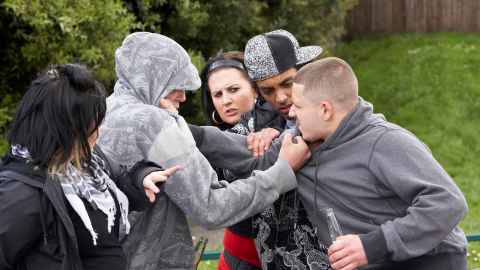Violence simply breeds violence at youth justice facilities
11 July 2023
Opinion: Despite aspirations for change, history tells us residential institutions for young offenders tend to default to a culture of conflict, threat, and coercion, says Ian Hyslop

Recent revelations suggesting sexually exploitive behaviour, young people breaking out onto the roof of the Korowai Manaaki residence, and a video of cage fight-style violence apparently overseen by staff is shocking and appalling. Sadly, I think ‘predictable’ is an equally accurate description.
Corrections Minister Kelvin Davis and the deputy CEO of Oranga Tamariki, Tusha Penny, have described this situation as unacceptable. What else could they say? Davis has announced a wide-ranging review of residences, led by the retired Police Commissioner Mike Bush and ‘aimed at flushing out inappropriate behaviour’.
I wish I could say this inspires confidence, but I can’t. My reluctance is not a reflection on the competence of the people involved. It is rather that the scope of the problem at hand is not about poor practice and the identification and removal of bad apples. The problem is systemic. It lies in the very nature of institutional care and the structural conditions that underpin its use.
We are awaiting the final report of the Abuse in Care Royal Commission. If this exercise isn’t a damning indictment on the practice of institutional care for children and young people, I don’t know what is.
The neoliberal expert panel review process of 2015 led to the creation of Oranga Tamariki and to the destructive practice seen in the Hastings uplift debacle. However, the associated changes to youth justice settings, aimed at support for care-leavers and raising the age of entry into the adult criminal justice system, were worthy objectives. Unfortunately, simple solutions to complex problems are seldom effective and the resourcing implications of these reforms were not well thought through. Serious challenges have resulted for the youth justice system. The current institutional care system is not fit for purpose.
Imagine the noise that would be provoked if a group of middle-class kids had been set up to give and receive severe mixed martial arts style beatings in a leafy suburban secondary school
We know treating young people in the same way as adult criminals does not work. We know prisons don’t work, for that matter. We also understand contemporary life is a different place for young people than it was 20 or 30 years ago.
We now have economic settings that explicitly generate insecurity and uncertainty. We have a social world alive with social media information and a range of illusions about choice and personal responsibility. We also have greater recognition of neurodiversity and socio-educational discrimination. It takes us a lot longer to ‘grow up’ in the 21st Century.
However, this growing up does not happen on a level playing field. We have deep divides in terms of wealth and opportunity structured by class, gender, and ethnicity in Aotearoa. We continue to have a liberal capitalist political and economic structure that excludes a section of the population from effective participation, a section of the population that occupy youth justice residences.
This is not a new phenomenon. Youth residences have always been populated by the children of the poor in this country as the Royal Commission process attests to. As the commission heard, youth programmes such as Whakapakari in the 1990s covertly encouraged fighting and rituals of domination.
State institutions routinely used ‘natural hierarchies’ and physical violence to embed ‘discipline’ – behavioural compliance and awareness of social status. All of this was hidden by the fact that this underclass of young people were in effect afforded a lesser set of human rights.
What has changed? There has been an outcry in response to the latest revelations, but it is an outcry ‘of sorts’ because we are dealing with a group who are classified as socially less deserving.
Imagine the noise that would be provoked if a group of middle-class kids had been set up to give and receive severe mixed martial arts style beatings in a leafy suburban secondary school.
Young people on the disadvantaged edges of our society do look for excitement, identity, and status by committing offences, compiling rap sheets, and bragging rights. This isn’t new either. If social norms don’t work for you, you find a place on the outside.
Despite aspirations for change, history tells us very clearly that residential institutions for young offenders tend to gravitate by default to this culture of conflict, threat, and coercion. The unspoken belief that this is what ‘these kids’ understand has been a subtext within these institutions since the 1950s. It is time to abandon this position: violence simply breeds violence.
First, we need to significantly dismantle secure institutional care for young people, because it doesn’t work for anybody.
The previous Children’s Commissioner, Andrew Becroft, argued for the development of smaller therapeutic group home facilities. I believe there has been some initial investment in this in the child protection area, but not enough and not with a youth justice focus.
Hard-end young offenders are difficult to manage, but if we really want to disrupt our racist pipeline to prison system, the state needs to seriously invest in alternatives.
Second, we need to address poverty and social inequality in this ‘good Kiwi’ land. This is what really generates fodder for the world of criminal justice. This is more complicated than removing a few bad apples. The barrel itself is infected. A fundamental rethinking of institutional care is required.
This article reflects the opinion of the author and not necessarily the views of Waipapa Taumata Rau University of Auckland.
This article was first published on Newsroom, Violence simply breeds violence at youth justice facilities, 11 July, 2023
Media contact
Margo White I Research communications editor
Mob 021 926 408
Email margo.white@auckland.ac.nz